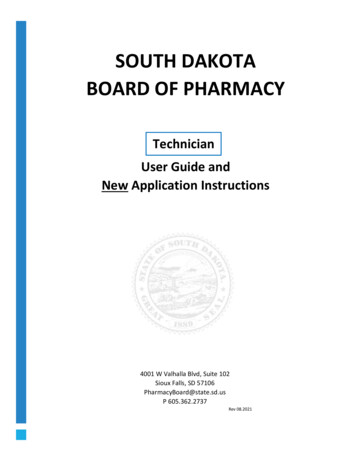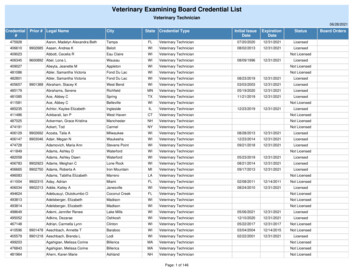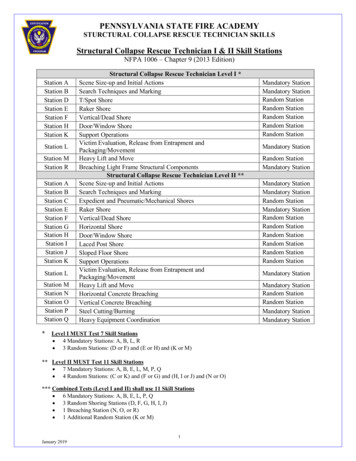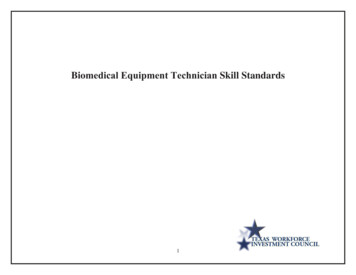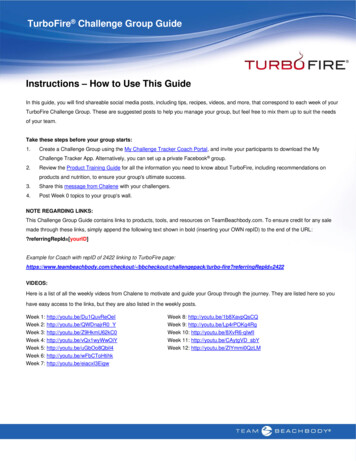
Transcription
By-the-Group Technician Class Amateur Radio License Study GuideFor the 2014 – 2018 Question PoolWelcome,So you want to get your Amateur Radio License.Good! This study guide is intended to help youprepare for the Technician Class license exam.This study guide is without detailed explanation. Yourclass instructors, other study guides, and on-linewebsites can provide explanation of and insight tothe many topics presented in this study guide.Student self-testing has proven invaluable in passingthe license exam. Self-testing has moved from inclass paper exams to on-line exams to smart phoneapps. If you have a smartphone, use a ham examapp to check and to reinforce your knowledge.The Technician Class License Exam The exam questions are drawn from a questionpool of 426 questions The questions are organized into 35 groups One exam question is drawn from each group A Technician Class license exam, therefore, has 35questions To pass, 26 questions must be answered correctly Morse code is no longer a part of the examFCC Registration Number (FRN) To take a license exam, you must have a FRN, thatis, a Federal Communication Commission (FCC)Registration Number When you register, your contact address becomesa FCC public record and will be available on-line.For privacy, some amateur radio operators chooseto register with a mailing address that is differentfrom their home address To register, visit https://apps.fcc.gov/coresAll rights reservedVersion 1.02, May 15, 2017Study Guides The No-Nonsense Technician Class License StudyGuide by Dan Romanchik, KB6NU. For explanationof a topic, try this study guide first. A free version isavailable at http://kb6nu.com/study-guides/. Technician Class FCC License Preparation forElement 2 Technician Class Theory 8th Edition,Gordon West, WB6NOA and Eric P. Nichols, KL7AJ,ISBN 978-0-945053-79-8 ARRL Ham Radio License Manual 3rd Edition, ISBN978-1-62595-013-0Self-Testing – Smart Phone Apps Many are available Android example: Ham Test PrepSelf-Testing – On line http://aa9pw.com/radio/technician/ http://arrlexamreview.appspot.com/index.html http://hamexam.org/ http://www.qrz.com/ht/ http://www.eham.net/exams/ https://hamstudy.org/Exam Locations xam-sessionBest wishes for success,Duane K. Allen, KK6EE
All rights reservedVersion 1.02, May 15, 2017
Group T5A – Basic ElectricityGroup T5D – Ohm’s LawElectrical Current Current is the flow of electrons in an electric circuit The unit of electrical current is the ampere Direct current (DC) is an electrical current that flows inonly one direction Alternating current (AC) is an electrical current thatreverses direction on a regular basis Frequency is the number of times per second that analternating current reverses directionCalculating Voltage Voltage (E)1 equals current (I) multiplied by resistance (R)Voltage Voltage is the electromotive force (EMF) that causeselectron flow The unit of electromotive force is the volt A mobile transceiver usually requires about 12 voltsE I R If 0.5 amperes flow through a 2-ohm resistor, the voltageacross the resistor is 1 voltE 0.5 A 2 1 V If 1 ampere flows through a 10-ohm resistor, the voltageacross the resistor is 10 voltsE 1 A 10 10 V If 2 amperes flow through a 10-ohm resistor, the voltageacross the resistor is 20 voltsE 2 A 10 20 VCalculating Current Current (I) equals voltage (E) divided by resistance (R)I E RElectrical Power Power is the rate at which electrical energy is used The unit of electrical power is the wattMaterials Copper is a good electrical conductor of electrical current Glass is a good electrical insulator In a circuit with an applied voltage of 120 volts and aresistance of 80 ohms, the current flow is 1.5 amperesI 120 V 80 1.5 A In a circuit with a 100-ohm resistor connected across200 volts, the current flow is 2 amperesI 200 V 100 2 A In a circuit with a 24-ohm resistor connected across 240volts, the current flow is 10 amperesI 240 V 24 10 ACalculating Resistance Resistance (R) equals voltage (E) divided by current (I)R E I . If the source is 90 volts and the current through theresistor is 3 amperes, then the resistance is 30 ohmsR 90 V 3 A 30 If applied voltage is 12 volts and the current flow is 1.5amperes, then the resistance is 8 ohmsR 12 V 1.5 A 8 If the source is 12 volts and the circuit draws 4 amperes,then the resistance is 3 ohmsR 12 V 4 A 3 1Some references, like Wikipedia, represent voltage withthe letter V and Ohm’s law as V IR.By-the-Group Technician Class Amateur Radio License Study Guide3
Group T5B – Units ConversionGroup T5C – Electrical UnitsPico-, Nano-, and Micro- Units 1,000,000 picofarads is 1 microfarad1,000,000 pF 1,000 nf 1 μF A microvolt is one one-millionth of a volt1 μV 0.001 mV 0.000 001 VRadio Frequencies A usual name for electromagnetic waves that travelthrough space is radio waves “RF” refers to radio frequency signals of all types The unit of frequency is the hertzMIlli- Units 500 milliwatts is 0.5 watts500 mW 0.500 W 0.5 W A current of 1.5 amperes is 1,500 milliamperesImpedance Impedance is a measure of the opposition to AC currentflow in a circuit The units of impedance are ohms1.5 A 1.500 A 1,500 mA If an ammeter is calibrated in amperes and is used tomeasure a 3000 milliampere current, then the meterwould show a reading of 3 amperes3000 mA 3.000 A 3 AKilo- , Mega- , and Giga- Units One kilovolt is one thousand volts1 kV 1.000 kV 1,000 V A radio signal frequency of 1,500,000 hertz is 1500 kHz1,5000,000 Hz 1,500.000 kHz 1,500 kHz If a frequency readout calibrated in megahertz shows areading of 3.525 MHz, then it would show 3525 kHz if itwere calibrated in kilohertz3.525 MHz 3525 kHz The frequency 28,400 kHz is 28.400 MHz28,400 kHz 28.400 MHz If a frequency readout shows a reading of 2425 MHz,then the frequency is 2.425 GHz2425 MHz 2.425 GHzCapacitance and Inductance The ability to store energy in an electric field is calledcapacitance The basic unit of capacitance is the farad The ability to store energy in a magnetic field is calledinductance The basic unit of inductance is the henryElectrical Power Power (P) equals voltage (E) multiplied by current (I)P E I If the applied voltage is 13.8 volts DC and the current is10 amperes, then the power being used is 138 wattsP 13.8 V 10 A 138 W When the applied voltage is 12 volts DC and the currentis 2.5 amperes, then the power is 30 wattsP 12 V 2.5 A 30 W When the applied voltage is 12 volts DC and the load is120 watts, there are 10 amperes flowing in the circuitI 120 W 12 V 10 APower Changes in Decibels (dB) Power END Power change 10 log dB Power BEGIN An increase from 5 watts to 10 watts is a power changeof approximately of 3 dB 10 W 10 log 10 log 2 3 dB 5W A decrease from 12 watts to 3 watts is a power changeof approximately - 6 dB 3W 1 10 log 10 log 6 dB 12 W 4 An increase from 20 watts to 200 watts is a powerincrease of 10 dB 200 W 10 log 10 log 10 10 dB 20 W 4By-the-Group Technician Class Amateur Radio License Study Guide
Group T6A – Passive ComponentsGroup T6B – Active ComponentsResistors A resistor is used to oppose the flow of current in a DCcircuit A potentiometer is a type of variable resistor. Apotentiometer is often used as an adjustable volumecontrol Resistance is the electrical parameter is controlled by apotentiometerTransistors Transistors are capable of using a voltage or currentsignal to control current flow The transistor can amplify signals The transistor can be used as an electronic switch oramplifier Gain is the term that describes a transistor's ability toamplify a signalCapacitors and Inductors A capacitor stores energy in an electric field A capacitor consists of two or more conductive surfacesseparated by an insulator An inductor stores energy in a magnetic field An inductor is usually composed of a coil of wireField Effect Transistors The abbreviation FET stands for Field Effect Transistor The source, gate, and drain are the three electrodes of afield effect transistorSwitches and Fuses A switch is used to connect or disconnect electricalcircuits A fuse is used to protect other circuit components fromcurrent overloadsBatteries All of the following battery types are rechargeableo Nickel-metal hydrideo Lithium-iono Lead-acid gel-cell A carbon-zinc battery type is not rechargeableBy-the-Group Technician Class Amateur Radio License Study GuideBipolar Junction Transistors The three electrodes of a PNP or NPN transistor are theemitter, base, and collector The transistor can be made of three layers ofsemiconductor materialDiodes The diode allows current to flow in only one direction The names of the two electrodes of a diode are theanode and cathode The cathode lead of a semiconductor diode is usuallyidentified with a stripe The abbreviation LED stands for Light Emitting Diode5
Group T6C – Schematic SymbolsSchematics The name for standardized representations ofcomponents in an electrical wiring diagram is schematicsymbols The symbols on an electrical circuit schematic diagramrepresent electrical components Electrical circuit schematic diagrams represent the waycomponents are interconnectedResistors Figure T1, component 1 is a resistor Figure T2, component 9 is a variable resistorFigure T1Capacitors Figure T2, component 6 is a capacitorInductors and Transformers Figure T2, component 4 is a transformer Figure T3, component 3 is a variable inductorSemiconductors Figure T1, component 2 is a transistor Figure T2, component 8 is a light emitting diodeFigure T2Some Other Components Figure T1, component 3 is a lamp Figure T1, component 4 is a battery Figure T3, component 4 is an antennaFigure T36By-the-Group Technician Class Amateur Radio License Study Guide
Group T6D – Component and Circuit FunctionsSwitches Figure T2, component 3 represents a single-pole singlethrow switch A relay is a switch controlled by an electromagnetSemiconductors The function of figure T1, component 2 (a transistor) isto control the flow of current A rectifier changes an alternating current into a varyingdirect current signal An integrated circuit combines several semiconductorsand other components into one packageFigure T1Indicators A LED is commonly used as a visual indicator A meter can be used to display signal strength on anumeric scalePower Supplies A regulator circuit controls the amount of voltage froma power supply A transformer is commonly used to change 120V AChouse current to a lower AC voltage for other usesFigure T2Tuned Circuit A simple resonant or tuned circuit is an inductor and acapacitor connected in series or parallel to form a filter A capacitor is used together with an inductor to make atuned circuitShielding A common reason to use shielded wire is to preventcoupling of unwanted signals to or from the wire For a 4-meeting course, this point ends meeting 1.By-the-Group Technician Class Amateur Radio License Study Guide7
Group T3B – Radio WavesGroup T3A – Radio SignalsElectromagnetic Waves The two components of a radio wave are the electric andmagnetic fields The orientation of the electric field of a radio wave is usedto describe its polarizationPropagation Electromagnetic waves carry radio signals betweentransmitting and receiving stations Inside buildings, UHF signals are often more effectivethan VHF signals because the shorter wavelength of UHFsignals allows them to more easily penetrate thestructure of buildings When using a directional antenna, and if buildings orobstructions are blocking the direct line of sight path,your station may be able to access a distant repeater ifyou try to find a path that reflects signals to the repeaterSpeed of Light (and Radio Waves) A radio wave travels through free space at the speed oflight The approximate velocity of a radio wave as it travelsthrough free space is 300,000,000 meters per secondRadio Frequency Spectrum Designations The frequency range of the high frequency spectrum (HF)is 3 to 30 MHz (Wavelength is 100 m to 10 m) The frequency range of the very high frequency spectrum(VHF) is 30 to 300 MHz (Wavelength is 10 m to 1 m) The frequency range of the ultra-high frequency spectrum(UHF) is 300 to 3000 MHz (Wavelength is 1 m to 10 cm)Wavelength Wavelength is the distance a radio wave travels duringone complete cycle The formula for converting frequency to approximatewavelength is wavelength in meters equals 300 dividedby frequency in megahertz, that is, 300 fMHzwhere λ (lambda) is wavelength in meters andfMHz is frequency in megahertz. The wavelength gets shorter as the frequency increases The approximate wavelength of radio waves is often usedto identify the different frequency bands8Multi-Path Distortion If another operator reports that your station’s 2 metersignals were strong just a moment ago, but now they areweak or distorted, the you should try moving a few feet orchanging the direction of your antenna if possible, asreflections may be causing multi-path distortion The term picket fencing is commonly used to describe therapid fluttering sound sometimes heard from mobilestations that are moving while transmitting The part of the atmosphere that enables the propagationof radio signals around the world is the ionosphere A likely cause of irregular fading of signals that are beingreceived by ionospheric reflection is the randomcombining of signals arriving via different paths If data signals propagate over multiple paths, error ratesare likely to increaseAntenna Polarization If the antennas at opposite ends of a VHF or UHF line ofsight radio link are not using the same polarization, thatis, both either horizontal or vertical, the signals could besignificantly weaker Horizontal antenna polarization is normally used for longdistance weak-signal CW and SSB contacts using the VHFand UHF bands Because skip signals refracted from the ionosphere areelliptically polarized, either vertically or horizontallypolarized antennas may be used for transmission orreceptionBy-the-Group Technician Class Amateur Radio License Study Guide
Group T3C –Propagation and EnvironmentGroup T9A – AntennasDirect Mode (Line-of-Sight) The radio horizon is the distance over which two stationscan communicate by direct path VHF and UHF radio signals usually travel somewhatfarther than the visual line of sight distance between twostations because the earth seems less curved to radiowaves than to light The reason that direct UHF signals are rarely heard fromstations outside your local coverage area is because UHFsignals are usually not reflected by the ionospherePolarization A simple dipole mounted so the conductor is parallel tothe Earth's surface is a horizontally polarized antenna For vertical antennas, the electric field is perpendicularto the EarthIonospheric Modes The ten and six meters bands may provide long distancecommunications during the peak of the sunspot cycle The best time generally for long-distance 10 meter bandpropagation via the F layer is from dawn to shortly aftersunset during periods of high sunspot activity A 6 meter 1/2-wavelength wire dipole antenna has anapproximate length of 112 inches0.95 2 0.95 6 2 39.37 in 112 in To make a dipole antenna resonant on a higherfrequency, you would shorten it “Loading” an antenna refers to inserting an inductor inthe radiating portion of the antenna to make it electricallylongerMeteor Scattering The 6 meters band is best suited for communicating viameteor scatterAuroral Backscatter A characteristic of VHF signals received via auroralreflection is that the signals exhibit rapid fluctuations ofstrength and often sound distortedSporadic E Propagation Often when VHF signals are being received from longdistances, it is because the signals are being refractedfrom a sporadic E layer Sporadic E is most common cause of occasional strongover-the-horizon signals on the 10, 6, and 2 meter bandsTropospheric Ducting Tropospheric ducting is caused by temperatureinversions in the atmosphere Tropospheric scatter is responsible for allowing over-thehorizon VHF and UHF communications to ranges of about300 miles on a regular basisKnife-Edge Diffraction Knife-edge diffraction might cause radio signals to beheard despite obstructions between the transmitting andreceiving stations For a 3-meeting course, this point ends meeting 1.By-the-Group Technician Class Amateur Radio License Study GuideElectrical Length A quarter-wavelength vertical antenna for 146 MHz hasan approximate length of 19 inches0.95 4 0.95 300 146 4 39.37 in 19 inRubber Duck Antennas A disadvantage of the “rubber duck” antenna suppliedwith most handheld radio transceivers is that it does nottransmit or receive as effectively as a full-sized antenna A good reason not to use a “rubber duck” antenna insideyour car is that signals can be significantly weaker thanwhen it is outside of the vehicleRadiation Pattern The direction in which the radiation is strongest from ahalf-wave dipole antenna in free space is broadside tothe antenna The gain of an antenna is the increase in signal strengthin a specified direction when compared to a referenceantenna A beam antenna is an antenna that concentrates signalsin one direction The quad, Yagi, and dish antennas are directionalantennas A reason to use a properly mounted 5/8 wavelengthantenna for VHF or UHF mobile service is that it offers alower angle of radiation and more gain than a 1/4wavelength antenna and usually provides improvedcoverage VHF or UHF mobile antennas are often mounted in thecenter of the vehicle roof because a roof mountedantenna normally provides the most uniform radiationpattern9
Group T9B – Coaxial CableGroup T7C – Antenna Systems MeasurementsCoaxial cables The reason that coaxial cable is used more often than anyother feed line for amateur radio antenna systems is thatit is easy to use and requires few special installationconsiderations As the frequency of a signal passing through coaxial cableis increased, the loss increases Air-insulated hard line has the lowest loss at VHF and UHFfrequencies In typical amateur radio installations, the impedance ofthe most commonly used coaxial cable is 50 ohms The electrical difference between the smaller RG-58 andlarger RG-8 coaxial cables is that the RG-8 cable has lessloss at a given frequencyCoaxial cable A common use of coaxial cable is carrying RF signalsbetween a radio and antenna The power lost in a feed line is converted into heat The most common cause for failure of coaxial cables ismoisture contamination The outer jacket of coaxial cable should be resistant toultraviolet light because ultraviolet light can damage thejacket and allow water to enter the cable When compared to foam or solid dielectric types, adisadvantage of air core coaxial cable is that it requiresspecial techniques to prevent water absorptionConnectors PL-259 type coax connectors are commonly used at HFfrequencies A Type N connector is the more suitable connector forfrequencies above 400 MHz Coax connectors that are exposed to the weather shouldbe sealed against water intrusion to prevent an increasein feed line lossMaintaining Low SWR (Standing Wave Ratio) In an antenna system that uses coaxial cable feed line, Itis important to have a low SWR in order to allow theefficient transfer of power and reduce losses An antenna tuner matches the antenna systemimpedance to the transceiver's output impedance Erratic changes in SWR readings could be caused by aloose connection in an antenna or a feed line10Antenna Analyzer An antenna analyzer can be used to determine if anantenna is resonant at the desired operating frequencyStanding Wave Ratio The standing wave ratio (SWR) is a measure of how wella load is matched to a transmission line A reading of 1 to 1 on an SWR meter indicates a perfectimpedance match between the antenna and the feed line An approximate SWR value of 2 to 1 and above causesthe protection circuits in most solid-state transmitters tobegin to reduce transmitter power An SWR reading of 4:1 indicates an impedance mismatch Instead of an SWR meter you could use a directionalwattmeter to determine if a feed line and antenna areproperly matchedDummy Load The primary purpose of a dummy load is to prevent theradiation of signals when making tests A dummy load consist of a non-inductive resistor and aheat sinkBy-the-Group Technician Class Amateur Radio License Study Guide
Group T8A – Radio Wave ModulationGroup T8D – Digital CommunicationsContinuous Wave (CW) CW has the narrowest bandwidth The approximate maximum bandwidth required totransmit a CW signal is 150 HzCW CW is sent using International Morse code All of the following can be used to transmit CW in theamateur bandso Straight Keyo Electronic Keyero Computer KeyboardSingle Sideband (SSB) Single sideband is a form of amplitude modulation The approximate bandwidth of a single sideband voicesignal is 3 kHz As a voice mode, SSB is most often used for long-distance(weak signal) contacts on the VHF and UHF bands For voice transmissions, the primary advantage of singlesideband over FM is that SSB signals have narrowerbandwidth Upper sideband is normally used for 10 meter HF, VHF,and UHF single-sideband communicationsFrequency Modulation (FM) The approximate bandwidth of a VHF repeater FM phonesignal is between 10 and 15 kHz FM is most commonly used for VHF and UHF voicerepeaters FM is most commonly used for VHF packet radiotransmissionsTelevision (TV)The typical bandwidth of analog fast-scan TVtransmissions on the 70 cm band is about 6 MHzDigital Digital communications methods include all of thefollowing exampleso Packeto PSK31o MFSK All the following may be included in packet transmissionso A check sum which permits error detectiono A header which contains the call sign of the station towhich the information is being sento Automatic repeat request in case of error PSK means Phase Shift Keying PSK31 is a low-rate data transmission mode An ARQ transmission system is a digital scheme wherebythe receiving station detects errors and sends a requestto the sending station to retransmit the informationAutomatic Packet Reporting System (APRS) “APRS” means Automatic Packet Reporting System An example of an application of APRS (Automatic PacketReporting System) is providing real time tactical digitalcommunications in conjunction with a map showing thelocations of stations A Global Positioning System receiver provides data to thetransmitter when sending automatic position reportsfrom a mobile amateur radio stationTV The term NTSC refers to an analog fast scan color TVsignalBy-the-Group Technician Class Amateur Radio License Study Guide11
Group T0A – Electrical SafetyGroup T0B – Antenna and Tower SafetyElectrical Shock Current flowing through the body causes all of thefollowing health hazardso By heating tissueo It disrupts the electrical functions of cellso It causes involuntary muscle contractions All of the following are good ways to guard againstelectrical shock at your stationo Use three-wire cords and plugs for all AC poweredequipmento Connect all AC powered station equipment to acommon safety groundo Use a circuit protected by a ground-fault interrupter The green wire in a three-wire electrical AC plug isconnected to the safety ground A hazard that might exist in a power supply when it isturned off and disconnected is that you might receive anelectric shock from the charged stored in large capacitorsAntenna Location Establish a minimum safe distance from a power linewhen installing an antenna so that if the antenna fallsunexpectedly, no part of it can come closer than 10 feetto the power wires Avoid attaching an antenna to a utility pole because theantenna could contact high-voltage power wiresFire Safety The purpose of a fuse in an electrical circuit is to interruptpower in case of overload It is unwise to install a 20-ampere fuse in the place of a5-ampere fuse because excessive current could cause afire Home-built equipment that is powered from 120V ACpower circuits should always include a fuse or circuitbreaker in series with the AC hot conductorBattery safety A hazard that is presented by a conventional 12-voltstorage battery is that explosive gas can collect if notproperly vented If a lead-acid storage battery is charged or discharged tooquickly the battery could overheat and give off flammablegas or explode A safety hazard of a 12-volt storage battery is thatshorting the terminals can cause burns, fire, or anexplosionWork Crew Safety An important safety precaution to observe when puttingup an antenna tower is to look for and stay clear of anyoverhead electrical wires A crank-up tower must never be climbed unless it is in thefully retracted position It is never safe to climb a tower without a helper orobserver Before climbing an antenna tower, put on a climbingharness and safety glasses Members of a tower work team should wear hard hatsand safety glasses at all times when any work is beingdone on the tower The purpose of a gin pole is to lift tower sections orantennasTower Grounding Local electrical codes establish grounding requirementsfor an amateur radio tower or antenna Proper grounding for a tower includes having separateeight-foot long ground rods for each tower leg, bonded tothe tower and each other When installing ground wires on a tower for lightningprotection, ensure that connections are short and direct Sharp bends must be avoided for the groundingconductors used for lightning protectionLightning Protection A precaution that should be taken when installing devicesfor lightning protection in a coaxial cable feed line is toground all of the protectors to a common plate which isin turn connected to an external ground 12For a 4-meeting course, this point ends meeting 2.For a 2-meeting course, this point ends meeting 1.By-the-Group Technician Class Amateur Radio License Study Guide
Group T0C – RF SafetyGroup T4A – Station SetupHealth Risk RF radiation differs from ionizing radiation because RFradiation does not have sufficient energy to causegenetic damage VHF and UHF radio signals are non-ionizing radiation The exposure limits vary with frequency because thehuman body absorbs more RF energy at somefrequencies than at others If a person accidentally touches your antenna while youare transmitting, they might receive a painful RF burnGrounding and Power A flat strap is the best conductor to use for RF grounding For communications equipment, use a regulated powersupply because it prevents voltage fluctuations fromreaching sensitive circuitsEvaluating Risk 50 watts PEP at the antenna is the maximum power levelthat an amateur radio station may use at VHFfrequencies before an RF exposure evaluation is required All of the following are acceptable methods to determinethat your station complies with FCC RF exposureregulationso By calculation based on FCC OET Bulletin 65o By calculation based on computer modelingo By measurement of field strength using calibratedequipment All of the following factors affect the RF exposure ofpeople near an amateur station antenna:o Frequency and power level of the RF fieldo Distance from the antenna to a persono Radiation pattern of the antenna 50 MHz has the lowest value for Maximum PermissibleExposure limit Duty cycle is one of the factors used to determine safe RFradiation exposure levels because it affects the averageexposure of people to radiation In calculating the average time of RF exposure, the dutycycle is the percentage of time that a transmitter istransmittingManaging Risk You can make sure your station stays in compliance withRF safety regulations by re-evaluating the stationwhenever an item of equipment is changed One way amateur operators can prevent exposure to RFradiation that exceed FCC-supplied limits is to relocateantennas If the averaging time for exposure is 6 minutes, 2 timesas much power density is permitted if the signal ispresent for 3 minutes and absent for 3 minutes ratherthan being present for the entire 6 minutesBy-the-Group Technician Class Amateur Radio License Study GuideMicrophones Microphone connectors on amateur transceivers differfrom each other because some connectors include pushto-talk and voltages for powering the microphone To cure distorted audio caused by RF current flowing onthe shield of a microphone cable, install a ferrite chokeon the cableComputers The ways that a computer could be used in an amateurradio station include all of the following:o For logging contacts and contact informationo For sending and/or receiving CWo For generating and decoding digital signals When using a computer in digital communications, thecomputer’s sound card provides audio to the microphoneinput and converts received audio to digital form In packet radio stations, a terminal node controller (TNC)connects the computer to the transceiverBetween Transmitter and Antenna To monitor the standing wave ratio of the station antennasystem, an in-line SWR meter should be installed in serieswith the feed line, between the transmitter and antenna A filter installed between the transmitter and the antennacan reduce any harmonic emission from your stationMobile Installations The negative return connector of a mobile transceiver'spower cable should be connected at the battery or engineblock ground strap If a mobile transceiver’s received audio has a highpitched whine that varies with engine speed, then thesource is the alternator if another operator reports a variable high-pitched whineon the audio from your mobile transmitter, then prob
So you want to get your Amateur Radio License. Good! This study guide is intended to help you prepare for the Technician Class license exam. This study guide is without detailed explanation. Your class instructors, other study guides, and on-line websites can provide explanation of and insight to the ma

